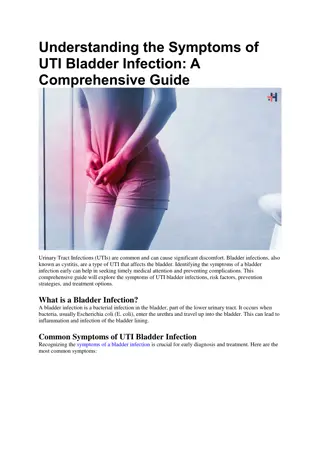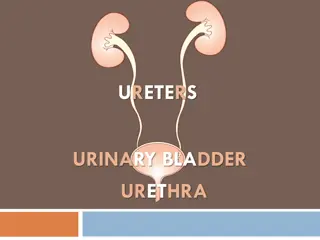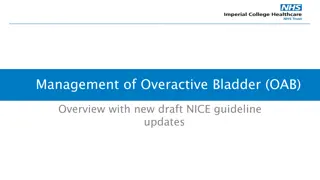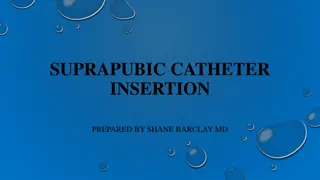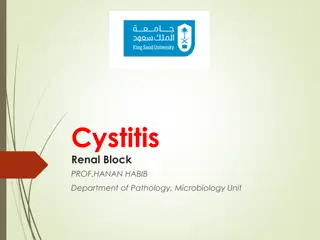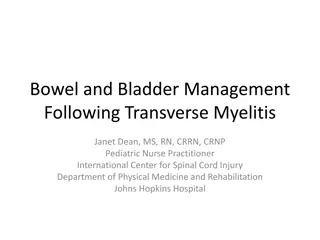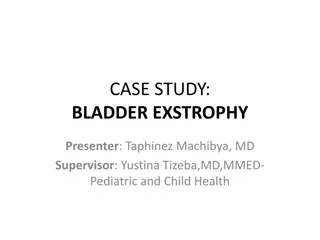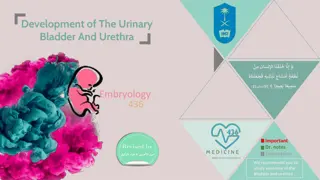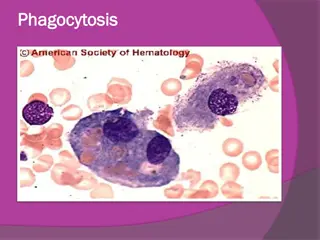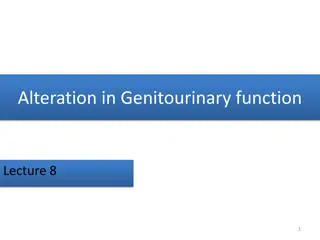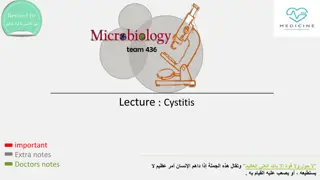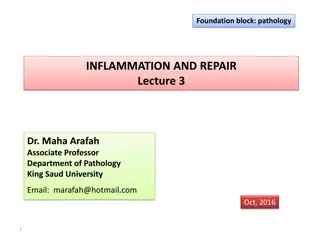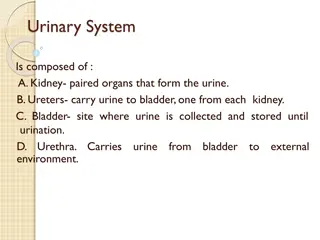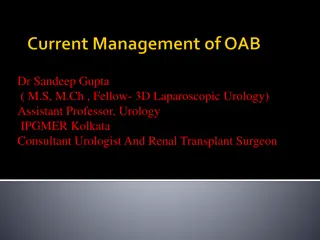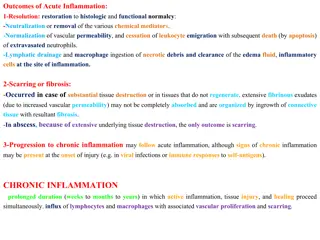Physiology of Micturition
The process of micturition (urination), the functional anatomy of the urinary bladder, neural control, the mechanism of filling and emptying of the bladder, and the neurogenic control of the micturition reflex and its disorders.
15 views • 23 slides
Understanding Urinary Elimination: Anatomy, Physiology, and Function of the Kidneys
The lecture covers the fundamentals of urinary elimination focusing on the kidneys' location, structure, function, and the role of nephrons. It discusses the transport of urine through the ureters to the bladder, highlighting the bladder's muscle layers and the urethra's role in expelling urine. Stu
3 views • 37 slides
Comprehensive Guide to Continuous Bladder Irrigation (CBI)
Explore the essential information about Continuous Bladder Irrigation (CBI), including its procedure, indications, supplies and equipment needed, documentation guidelines, and monitoring protocols. Learn about the importance of CBI in post-prostate surgery, urinary tract obstruction prevention, clot
5 views • 14 slides
Understanding Urinary Incontinence in the Elderly
The urinary system plays a vital role in regulating blood volume, pressure, and waste excretion. Urinary incontinence in the elderly can be caused by weak bladder muscles or neurological issues. The bladder consists of 4 layers, each serving a specific function. Normal voiding frequency and bladder
0 views • 50 slides
Understanding COX Enzymes and Their Impact on Pain and Inflammation
COX enzymes, including COX1, COX2, and COX3, play a crucial role in synthesizing prostanoids like prostaglandins in the body, affecting pain and inflammation. By inhibiting these enzymes, relief from pain and inflammation can be achieved. However, non-selective COX inhibitors may lead to various sid
0 views • 21 slides
Understanding the Link Between Diet, Inflammation, and Chronic Diseases
Inflammation is the body's natural response to injury, infection, or attack, but chronic low-grade inflammation can lead to various diseases. The immune system plays a crucial role in protecting the body against harmful substances. Chronic diseases like obesity, diabetes, and cancer often have under
1 views • 17 slides
Veterinary Anatomy of Urinary System in Different Animals
The urinary system in animals includes kidneys, ureters, and the bladder, all crucial for filtration and urine excretion. The ureters are excretory ducts from the kidneys, while the bladder stores urine before expulsion. Various diagrammatic structures illustrate the urogenital system of animals, pa
0 views • 20 slides
Understanding the Symptoms of UTI Bladder Infection
This comprehensive guide will explore the symptoms of UTI bladder infections, risk factors, prevention strategies, and treatment options.
0 views • 5 slides
Understanding Inflammation and Its Characteristics
Inflammation is the response of tissues to harmful agents, categorized as acute or chronic. Acute inflammation is rapid and short-lived, while chronic inflammation is insidious and prolonged. Chemical mediators play a crucial role in both forms, leading to tissue necrosis. The five cardinal signs of
3 views • 27 slides
Understanding the Anatomy of Ureters, Urinary Bladder, and Urethra
Explore the detailed anatomy of ureters, urinary bladder, and urethra in this comprehensive guide. Learn about the course of ureters, important relations of the urinary bladder, and differences in male and female urethra. Discover the sites of ureteric constrictions, arterial blood supply, and more.
0 views • 22 slides
Understanding Cellular Events in Inflammation and Repair
Explore the lecture on Cellular Events in Inflammation by Dr. Maha Arafah, focusing on the sequence of vascular changes in acute inflammation, phases of changes in vascular caliber and flow, and objectives covering leukocyte extravasation, chemotaxis, phagocytosis, and microbial killing. Reference m
0 views • 47 slides
Understanding Inflammation and Repair in Tissue Response
Inflammation is a crucial process in response to tissue injury, aiming to eliminate harmful agents and promote healing. It involves vascular changes, increased permeability, and the formation of edema. Repair follows inflammation, involving regeneration and fibroblastic tissue formation. While infla
0 views • 57 slides
Overview of Bladder Tumours: Causes, Symptoms, and Diagnosis
Bladder tumours, particularly Transitional Cell Carcinoma (TCC), are the second most common cancer in the genitourinary system. Mainly caused by factors like cigarette smoking, industrial toxins, and genetic events, bladder cancer presents with symptoms such as hematuria and irritative voiding sympt
0 views • 26 slides
Gall Bladder Cancers in India: A Report from Population Based Cancer Registries (1982-2010)
This report discusses the incidence rates of gall bladder cancers in various regions worldwide, focusing on India. It highlights the significant disparity in rates across different countries and regions. The data analysis includes age-adjusted incidence rates from specific districts in India, as wel
0 views • 34 slides
Management of Overactive Bladder (OAB) - Overview and Guidelines Update
Learn about the assessment, tests, conservative and surgical management options for Overactive Bladder (OAB) based on the new draft NICE guideline updates. Understand the categorization of urinary incontinence types, urine testing protocols, bladder diaries, quality of life assessments, and the role
1 views • 30 slides
Chemical Mediators of Inflammation: Understanding Sources and Effects
Chemical mediators of inflammation play a pivotal role in inducing specific events during acute inflammation. These mediators are produced in response to various triggers, including microbial products and host proteins, leading to a cascade of inflammatory responses. Understanding the sources and ef
1 views • 43 slides
Suprapubic Catheter Insertion Procedure Guidelines
Suprapubic catheter insertion is a procedure indicated for conditions such as urethral injury, obstruction, bladder neck masses, and benign prostatic hypertrophy. It involves proper patient positioning, analgesia, equipment preparation, and a step-by-step technique including bladder palpation, marki
1 views • 12 slides
Understanding Cystitis: Causes, Symptoms, and Management
Cystitis is a common urinary tract infection affecting both men and women, characterized by inflammation of the bladder mucosa. This article covers the definition, pathogenesis, risk factors, causative organisms, types, diagnostic methods, and treatment options for cystitis, emphasizing the importan
0 views • 24 slides
Bowel and Bladder Management Post Transverse Myelitis
Following transverse myelitis, there can be significant changes in bowel and bladder function, impacting storage, release, and coordination. Neurogenic bowel and bladder issues, differentiated by injury level, can lead to challenges in controlling sphincters and bathroom habits. Understanding these
0 views • 23 slides
Case Study: Bladder Exstrophy in Infant - Presentation and History
Bladder exstrophy case study of a 12-day-old female infant with abnormal swelling and opening in the lower abdomen since birth. The patient's history includes antenatal, natal, and postnatal details without complications. Family-social background information is provided.
0 views • 35 slides
Role of REG3 and I-FABP in HIV-Related Gut Permeability and Inflammation
This presentation highlights the significance of Regenerating Islet-Derived Protein-3 (REG3) and Intestinal Fatty Acid Binding Protein (I-FABP) in microbial translocation, inflammation, and reservoir size in individuals living with HIV. REG3 and I-FABP serve as markers of gut epithelial damage and p
0 views • 7 slides
Development of the Urinary Bladder and Urethra in Embryology
Understanding the embryonic development of the urinary bladder and urethra involves studying the formation of the cloaca, division of the urogenital sinus, absorption of mesonephric ducts, position and fate of the urachus, and anomalies related to these structures. The cloaca, primitive urogenital s
0 views • 14 slides
Understanding Bowel and Bladder Issues Post Stroke
Bowel and bladder incontinence are common after a stroke, often due to brain damage affecting control functions. Factors like mobility can exacerbate these issues, leading to discomfort, infections, and other complications. Managing incontinence involves assessing individual needs, recognizing signs
0 views • 10 slides
Understanding Phagocytosis, Inflammation, and Granulomas in Tuberculosis
Phagocytosis is a crucial process where cells engulf and digest pathogens. Inflammation responses involve various immune cells like neutrophils, plasma cells, lymphocytes, and macrophages. Granulomas, typical in diseases like tuberculosis, are mass accumulations in chronic inflammation. Tuberculosis
0 views • 18 slides
Understanding Alterations in Genitourinary Function: An Overview
The genitourinary system comprises the urinary and reproductive organs, with the kidneys, ureters, bladder, and urethra playing crucial roles. Maintaining proper function involves factors like renal blood flow, glomerular filtration, tubular function, and urine flow. Nephrons are the functional unit
0 views • 58 slides
Understanding Cystitis: Causes, Symptoms, and Treatment Options
Cystitis is a common bladder infection that can affect both men and women. This lecture provides important information on the pathogenesis, causative organisms, diagnosis, and treatment of cystitis. Learn about the risk factors, types of cystitis, and how venereal diseases can present with symptoms
0 views • 16 slides
Updates on TNM-8 Staging for Urological Cancers: Insights by John Mitchard
An update by Consultant Histopathologist John Mitchard on TNM-8 staging for urological cancers, highlighting changes in RCC definitions and grading, along with minor adjustments in bladder staging. Details include revised pT3 criteria for kidney tumors, improvements in bladder M1 and T2 classificati
0 views • 14 slides
Understanding the Physiology of Micturition: Bladder Function and Control Mechanisms
Explore the intricacies of micturition physiology focusing on the functional anatomy of the urinary bladder, mechanism of filling and emptying, cystometrogram, and neurogenic control. Delve into the internal structure of the bladder, sphincters, and innervation in males for a comprehensive understan
0 views • 20 slides
Understanding the Outcomes and Patterns of Inflammation in Pathology
The lecture by Dr. Maha Arafah delves into the outcomes and patterns of acute inflammation, discussing outcomes like complete resolution, fibrosis, chronic inflammation progression, and abscess formation. It also covers chemical mediators, morphologic patterns, and events in inflammation resolution,
0 views • 50 slides
Stroke Continence Protocols for Managing Bladder and Bowel Function After Stroke
This protocol outlines the management of urinary and bowel incontinence in stroke patients, emphasizing high nursing care levels and avoiding unnecessary catheterization. It discusses normal bladder functions, urinary dysfunction prevalence post-stroke, and interventions for promoting continence. Ur
0 views • 30 slides
Understanding the Human Urinary System
The human urinary system consists of the kidneys, ureters, bladder, and urethra. The kidneys filter blood to produce urine, which is carried to the bladder through the ureters for storage until excretion. Each kidney is structured with renal pyramids and nephrons for blood filtration and waste remov
0 views • 16 slides
Gall Bladder and Bile Duct
The gall bladder and bile ducts play crucial roles in the storage and transportation of bile in the body. They have specific anatomical divisions and functions, including bile secretion, concentration, and storage. Understanding their structure and function is essential for grasping their physiologi
0 views • 32 slides
Comprehensive Overview of Immunotherapy in Bladder and Renal Cancer Management
Explore the latest advancements in immunotherapy for managing bladder and renal cancer, including mechanisms of action, indications, adverse effects, and available treatment regimes. Learn about immune checkpoint inhibitors, differentiating immunotherapy from chemotherapy, indications for use across
0 views • 19 slides
Understanding Voiding Disorders in Children: An Overview by Dr. Manas Kr. Mahapatra
Voiding disorders in children, also known as bladder dysfunction, are a common issue affecting up to 40% of pediatric urology clinic visits. These disorders can indicate underlying pathophysiology requiring treatment to prevent renal or urologic damage. The development of urinary control by age 5 is
0 views • 53 slides
Understanding the Urinary System: Bladder Anatomy and Function
Exploring the anatomy and physiology of the urinary system with a focus on the bladder, including details on muscle structure, capacity for urine collection, and the role of the detrusor muscle in micturition. Learn about key components such as the trigone and bladder neck, as well as innervation an
0 views • 19 slides
Understanding Continence Care in the Community
Continence care in the community focuses on maintaining normal bladder and bowel functions to support individuals in managing their toileting needs effectively. Continence involves being aware of bodily signals, knowing when and how to void or defecate, managing clothing, storing urine or bowel move
0 views • 38 slides
Understanding Overactive Bladder: Symptoms and Treatment Options
Overactive bladder (OAB) is a common condition characterized by urinary urgency, frequency, and sometimes incontinence. It significantly impacts quality of life and can affect individuals of all ages, with higher prevalence in older populations. Treatment options include drug therapy, bladder traini
0 views • 47 slides
Understanding Bladder Trauma: Etiology, Pathophysiology, and Management
Bladder trauma commonly occurs due to pelvic trauma or surgical interventions, leading to injuries like contusion, intraperitoneal rupture, and extraperitoneal rupture. Dr. Nagwa M. Ahmed presents key elements of bladder trauma, including its etiology, pathophysiology, clinical presentation, diagnos
0 views • 16 slides
Understanding Acute and Chronic Inflammation: Causes, Outcomes, and Resolution
Acute inflammation results in either resolution or progression to chronic inflammation, with outcomes like restoration of normalcy, fibrosis, or scarring. Chronic inflammation can be caused by viral infections, persistent microbial infections, exposure to toxic agents, or autoimmune diseases. Macrop
0 views • 27 slides
Overview of Chronic Inflammation: Causes, Effects, and Patterns
Chronic inflammation, a prolonged inflammatory process lasting weeks to years, involves a complex interplay of cells and tissue changes leading to fibrosis. This type of inflammation can arise from persistent infections by microbes or immune-mediated inflammatory diseases. Understanding the causes,
0 views • 41 slides







